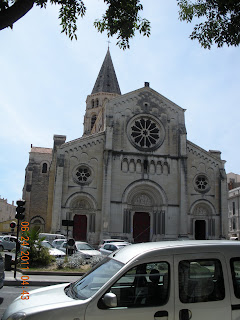The lovely thing about being in the south of France is that everything ALSO in the south of France is pretty close--so, yesterday, I jumped on the train and rode to the city of Nimes in about 2 hours and 20 minutes. Taking the European trains is a great way to see the countryside and also (as it turns out) meet some nice people. Besides, you don't have to drive, you don't have to use up gas, and you can actually READ on the train!
Nimes is the ancient city which was claimed by Rome at least prior to 28 BC--it was the "Colonius Nemensis", and for soldiers who served Julius Caesar for 15 years, a tract of land in that colony was their reward. Even then it was known as a great area for vineyards! It was a vital city with 50,000 people at the time of Caesar Augustus; later, it was known for its cloth and dyes in varying shades of blue, due to a certain species of WOAD plant which grows there, and the serge (cloth) de Nimes became famous even in medieval times--we know it as "de Nimes" or "denim" now. A Frenchman named Levy-Strauss (not to be confused with the anthropologist of the same name) came to America in the 1920s with his cloth and began making work-pants for farmers and ranchers--they were called "Levis", and we know them today as (blue) jeans.
Nimes has the oldest, and most complete, Roman Colisseum in all of Europe (or the world, for that matter)--it's still in shape after 2,000 years, such that they use it as a venue for concerts today! It's elliptical in shape, whereas the one in Rome was round. They also have a complete Temple to the Goddess Vesta, which was dedicated to the sons of Caesar Agrippa at the time it was built (we saw the site, on Palatine Hill in Rome, where the two temples of Vesta used to be--the eternal flame there was tended by the Vestal Virgins, you know). Anyway--pretty cool that these structures still exist, and that they are just in the center of town--the modern city has built up around them. France does have history, that's for sure. (They use the arena, or colissum, for bullfights--which were actually an ancient Roman sporting event--I know we all think of bullfights as Spanish only, but they also occur across the south of France--the entire area of southern France and northern Spain was once the country of Occitane. The culture of southern France is more similar to northern Spain than it is to the northern part of France.)
On the way back from Nimes, I sat on the train with a gentleman who is 72, named Joc (Jacques) Arnal, a Frenchman who grew up near Nimes and is here on a reunion trip, or, as he says, "a trip down the lane of memories". He had been at a reunion and was on his way to his sister-in-law's house (his "belle soeur") in Perpignan, a town on the seacoast near the Spanish border. We chatted in French and then English and then back to French again all the way to Narbonne, where I left that train to catch the local train back to Carcassonne. It turns out he lives now in Vancouver, Washington, where his wife, a linguist, teaches in Portland, OR. He is retired now, but has travelled the world for his work (he met his American wife in Tunisia). We talked philosophy, politics, children and (his) grandchildren, and how one can leave a legacy for family members. He was reading Stendahl's "Le Rouge et le Noir" ("The Red and the Black"), one of the 100 Great Books Curriculum for colleges. Now I'm going to have to read that . . . it was altogether an enlightening day!
Oh, did I mention that it was 78 degrees with a light breeze? As Joc said, "in Washington State, rain is a way of life, but not in France!"






No comments:
Post a Comment